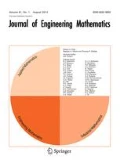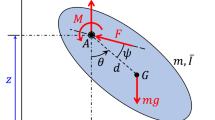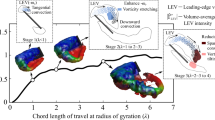Abstract
In this study, mathematical modeling of fluid flow and numerical simulations were used to determine the effects of adding small amplitude stroke deviation to the typical normal-hovering mode on the aerodynamics of small insect flight at Reynolds numbers (Re) in the range 4–20. Here, “small” implies that the ratio of surging to plunging amplitude is much less than unity. The immersed boundary method was used to solve the fully coupled fluid–structure interaction problem of a wing immersed in a two-dimensional viscous fluid. Different types of surging motion with a small amplitude were added to the typical normal-hovering mode that has no stroke deviation to generate two oval-shaped and two figure-eight trajectories. The results of this study suggest that for Re in the range 4–20, adding small amplitude stroke deviation to the typical normal-hovering mode has a modest influence on the time-averaged vertical force and aerodynamic efficiency. The impact on the instantaneous aerodynamic forces (pressure, viscous, and vertical forces), however, is considerable. This, in turn, is very likely to considerably alter the noise characteristics of the wing. The small impact on the time-averaged vertical force results from the trajectories with stroke deviation consisting of sub-intervals with large gains and sub-intervals with large losses in the instantaneous vertical force relative to the typical normal-hovering mode nearly offsetting each other. Adding small amplitude stroke deviation to the typical normal-hovering mode that is considered to be incapable of enabling flight at the scale of tiny insects does not seem to offer any significant benefit in terms of weight-supporting capability. Nevertheless, this study may inform the development of miniature drones that utilize the typical normal-hovering mode for staying aloft.
































Similar content being viewed by others
References
Miller LA, Peskin CS (2004) When vortices stick: an aerodynamic transition in tiny insect flight. J Exp Biol 207:3073–3088
Miller LA, Peskin CS (2005) A computational fluid dynamics study of clap and fling in the smallest insects. J Exp Biol 208:195–212
Miller LA, Peskin CS (2009) Flexible clap and fling in tiny insect flight. J Exp Biol 212:3076–3090
Wang ZJ (2000) Two dimensional mechanism for insect hovering. Phys Rev Lett 85(10):2216
Zz WANG, Yq LIU, Min S et al (2019) Parasitoid wasps as effective biological control agents. J Integr Agric 18(4):705–715
Jones S, Laurenza R, Hedrick TL et al (2015) Lift vs. drag based mechanisms for vertical force production in the smallest flying insects. J Theoret Biol 384:105–120
Morse JG, Hoddle MS (2006) Invasion biology of thrips. Annu Rev Entomol 51:67–89
Shogren C, Paine T (2016) Economic benefit for cuban laurel thrips biological control. J Econ Entomol 109(1):93–99
Ellington C (1999) The novel aerodynamics of insect flight: applications to micro-air vehicles. J Exp Biol 202(23):3439–3448
Sane SP (2003) The aerodynamics of insect flight. J Exp Biol 206:4191–4208
Weis-Fogh T (1973) Quick estimates of flight fitness in hovering animals, including novel mechanisms for lift production. J Exp Biol 59:169–230
Horridge GA (1956) The flight of very small insects. Nature 178:1334–1335
Ellington CP (1984) The aerodynamics of hovering insect flight. IV. Aerodynamic mechanisms. Philos Trans R Soc Lond B Biol Sci 305:79–113
Ristroph L, Bergou AJ, Guckenheimer J et al (2011) Paddling mode of forward flight in insects. Phys Rev Lett 106(17):178,103
Wang ZJ (2004) The role of drag in insect hovering. J Exp Biol 207(23):4147–4155
Miller L, Senter M, Jones S, et al (2020) Flexible clap and peel in the smallest insects. In: APS Division of Fluid Dynamics Meeting Abstracts, pp X02–014
Aghav H, Miller L (2021) Two-dimensional aerodynamic analysis of flight in the smallest insects. Bull Am Phys Soc
Santhanakrishnan A, Miller L, Lowe A et al (2013) Clap and fling in tiny insect flight: role of the porous flow introduced by bristled wings. Integr Compar Biol 53(S1):E189
Jones SK, Yun YJ, Hedrick TL et al (2016) Bristles reduce the force required to fling wings apart in the smallest insects. J Exp Biol 219(23):3759–3772
Ford MP, Kasoju VT, Gaddam MG et al (2019) Aerodynamic effects of varying solid surface area of bristled wings performing clap and fling. Bioinspir Biomimet 14(4):046,003
Kasoju VT, Santhanakrishnan A (2021) Aerodynamic interaction of bristled wing pairs in fling. Phys Fluids 33(3):031,901
Kasoju VT, Moen DS, Ford MP et al (2021) Interspecific variation in bristle number on forewings of tiny insects does not influence clap-and-fling aerodynamics. J Exp Biol 224(18):jeb239,798
Lee SH, Kim D (2017) Aerodynamics of a translating comb-like plate inspired by a fairyfly wing. Phys Fluids 29(081):902
O’Callaghan F, Sarig A, Ribak G et al (2022) Efficiency and aerodynamic performance of bristled insect wings depending on Reynolds number in flapping flight. Fluids 7(2):75
Sato K, Takahashi H, Minh-Dung N, et al (2013) Effectiveness of bristled wing of thrips. In: 2013 IEEE 26th international conference on micro electro mechanical systems (MEMS). IEEE, pp 21–24
Jiang Y, Zhao P, Cai X et al (2022) Bristled-wing design of materials, microstructures, and aerodynamics enables flapping flight in tiny wasps. Iscience 25(1):103,692
Sun M, Yu X (2006) Aerodynamic force generation in hovering flight in a tiny insect. AIAA J 44(7):1532–1540
Cheng X, Sun M (2018) Very small insects use novel wing flapping and drag principle to generate the weight-supporting vertical force. J Fluid Mech 855:646–670
Cheng X, Sun M (2019) Revisiting the clap-and-fling mechanism in small wasp encarsia formosa using quantitative measurements of the wing motion. Phys Fluids 31(10):101,903
Cheng X, Sun M (2021) Wing kinematics and aerodynamic forces in miniature insect encarsia formosa in forward flight. Physics of Fluids 33(2):021,905
Engels T, Kolomenskiy D, Lehmann FO (2021) Flight efficiency is a key to diverse wing morphologies in small insects. J R Soc Interface 18(183):20210,518
Farisenkov SE, Kolomenskiy D, Petrov PN, et al (2021) A novel flight style allowing the smallest featherwing beetles to excel. bioRxiv
Farisenkov SE, Kolomenskiy D, Petrov PN, et al (2022) Novel flight style and light wings boost flight performance of tiny beetles. Nature 1–5
Kolomenskiy D, Farisenkov S, Engels T et al (2020) Aerodynamic performance of a bristled wing of a very small insect. Exp Fluids 61(9):1–13
Ellington CP, Van Den Berg C, Willmott AP et al (1996) Leading-edge vortices in insect flight. Nature 384(6610):626–630
Hu F, Liu X (2019) Effects of stroke deviation on hovering aerodynamic performance of flapping wings. Phys Fluids 31(11):111,901
Lua KB, Lee Y, Lim T et al (2016) Aerodynamic effects of elevating motion on hovering rigid Hawkmothlike wings. AIAA J 54(8):2247–2264
Sane SP, Dickinson MH (2001) The control of flight force by a flapping wing: lift and drag production. J Exp Biol 204(15):2607–2626
Jones SK (2016) A computational fluid dynamics study of the smallest flying insects. PhD thesis, The University of North Carolina at Chapel Hill
Wang ZJ, Birch JM, Dickinson MH (2004) Unsteady forces and flows in low Reynolds number hovering flight: two-dimensional computations vs robotic wing experiments. J Exp Biol 207(3):449–460
Jensen M (1956) Biology and physics of locust flight. III. The aerodynamics of locust flight. Philosoph Trans R Soc Lond Ser B Biol Sci 239(667):511–552
Nachtigall W (1973) Insects in flight: a glimpse behind the scenes in biophysical research. McGraw-Hill, New York
Peskin CS (1972) Flow patterns around heart valves: a numerical method. J Comput Phys 10(2):252–271
Peskin CS (1977) Numerical analysis of blood flow in the heart. J Comput Phys 25(3):220–252
Peskin CS (2002) The immersed boundary method. Acta Numer 11:479–517
Griffith BE, Luo X, McQueen DM et al (2009) Simulating the fluid dynamics of natural and prosthetic heart valves using the immersed boundary method. Int J Appl Mech 1(01):137–177
Hoover AP, Griffith BE, Miller LA (2017) Quantifying performance in the medusan mechanospace with an actively swimming three-dimensional jellyfish model. J Fluid Mech 813:1112–1155
Miles JG, Battista NA (2019) Naut your everyday jellyfish model: exploring how tentacles and oral arms impact locomotion. Fluids 4(3):169
Taheri A (2018) Lagrangian coherent structure analysis of jellyfish swimming using immersed boundary FSI simulations. J Mech Civ Eng 15(1):69–74
Lim S, Peskin CS (2012) Fluid-mechanical interaction of flexible bacterial flagella by the immersed boundary method. Phys Rev E 85(3):036,307
Maniyeri R, Suh YK, Kang S et al (2012) Numerical study on the propulsion of a bacterial flagellum in a viscous fluid using an immersed boundary method. Comput Fluids 62:13–24
Griffith B (2013) Ibamr: an adaptive and distributed-memory parallel implementation of the immersed boundary method
Hornung RD, Wissink AM, Kohn SR (2006) Managing complex data and geometry in parallel structured AMR applications. Eng Comput 22(3):181–195
Wissink AM, Hornung RD, Kohn SR, et al (2001) Large scale parallel structured AMR calculations using the Samrai framework. In: Proceedings of the 2001 ACM/IEEE conference on Supercomputing, p 6
Balay S, Gropp WD, McInnes LC, et al (1997) Efficient management of parallelism in object-oriented numerical software libraries. In: Modern software tools for scientific computing. Springer, New York, pp 163–202
Balay S, Buschelman K, Eijkhout V, et al (2008) Petsc users manual tech. rep. Tech. rep., ANL-95/11-Revision 3.0. Argonne National Laboratory
Falgout R, Cleary A, Jones J, et al (2010) Hypre: high performance preconditioners. Users Manual Version 1
Falgout RD, Yang UM (2002) hypre: A library of high performance preconditioners. In: International Conference on Computational Science. Springer, New York, pp 632–641
Kirk BS, Peterson JW, Stogner RH et al (2006) libmesh: a c++ library for parallel adaptive mesh refinement/coarsening simulations. Eng Comput 22(3):237–254
Harrison C (2021) Visualization and analysis of hpc simulation data with visit. PhD thesis, Lawrence Livermore National Laboratory
Luo G, Du G, Sun M (2018) Effects of stroke deviation on aerodynamic force production of a flapping wing. AIAA J 56(1):25–35
Seo JH, Menon K, Mittal R (2022) A method for partitioning the sources of aerodynamic loading noise in vortex dominated flows. Phys Fluids
Ellington CP (1984) The aerodynamics of hovering insect flight. III. Kinematics. Philos Trans R Soc Lond B Biol Sci 305:41–78
Lehmann FO, Pick S (2007) The aerodynamic benefit of wing-wing interaction depends on stroke trajectory in flapping insect wings. J Exp Biol 210(8):1362–1377
Lehmann FO, Sane SP, Dickinson M (2005) The aerodynamic effects of wing-wing interaction in flapping insect wings. J Exp Biol 208(16):3075–3092
Lighthill M (1973) On the Weis-Fogh mechanism of lift generation. J Fluid Mech 60(1):1–17
Mao S, Xin Y (2003) Flows around two airfoils performing fling and subsequent translation and translation and subsequent clap. Acta Mech Sin 19(2):103–117
Maxworthy T (1979) Experiments on the Weis-Fogh mechanism of lift generation by insects in hovering flight. Part 1. Dynamics of the fling. J Fluid Mech 93(1):47–63
Spedding G, Maxworthy T (1986) The generation of circulation and lift in a rigid two-dimensional fling. J Fluid Mech 165:247–272
Acknowledgements
High-Performance computing resources for this work were provided by the University of Arizona’s Research Data Center (RDC). The author thanks the anonymous reviewers for their constructive comments that greatly improved the manuscript.
Funding
This research received no external funding.
Author information
Authors and Affiliations
Corresponding author
Ethics declarations
Conflicts of interest
There is no conflict of interest or competing interests associated with this project.
Additional information
Publisher's Note
Springer Nature remains neutral with regard to jurisdictional claims in published maps and institutional affiliations.
Appendix A: Variation of non-dimensional forces with dimensionless time for all the stroke patterns
Appendix A: Variation of non-dimensional forces with dimensionless time for all the stroke patterns
The following figures (Figures 33, 34, 35, 36, and 37) present the variation of \(C_\mathrm{{H}}\) and \(C_\mathrm{{V}}\) with non-dimensional time during the third and fourth stroke cycles for all the stroke patterns considered in this study.
Rights and permissions
Springer Nature or its licensor (e.g. a society or other partner) holds exclusive rights to this article under a publishing agreement with the author(s) or other rightsholder(s); author self-archiving of the accepted manuscript version of this article is solely governed by the terms of such publishing agreement and applicable law.
About this article
Cite this article
Aghav, H. Effects of stroke deviation on the aerodynamics of the smallest flying insects. J Eng Math 137, 4 (2022). https://doi.org/10.1007/s10665-022-10242-7
Received:
Accepted:
Published:
DOI: https://doi.org/10.1007/s10665-022-10242-7









